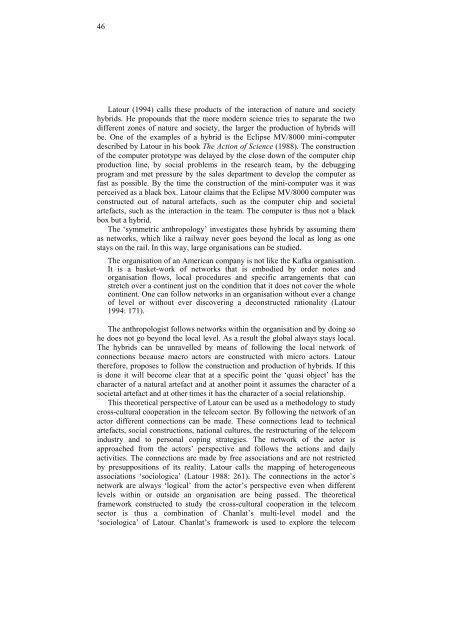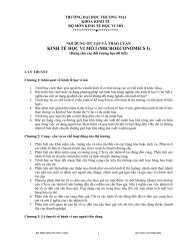The Internationalisation of PTT Telecom: A Cultural Perspective - Free
The Internationalisation of PTT Telecom: A Cultural Perspective - Free
The Internationalisation of PTT Telecom: A Cultural Perspective - Free
- No tags were found...
You also want an ePaper? Increase the reach of your titles
YUMPU automatically turns print PDFs into web optimized ePapers that Google loves.
46Latour (1994) calls these products <strong>of</strong> the interaction <strong>of</strong> nature and societyhybrids. He propounds that the more modern science tries to separate the twodifferent zones <strong>of</strong> nature and society, the larger the production <strong>of</strong> hybrids willbe. One <strong>of</strong> the examples <strong>of</strong> a hybrid is the Eclipse MV/8000 mini-computerdescribed by Latour in his book <strong>The</strong> Action <strong>of</strong> Science (1988). <strong>The</strong> construction<strong>of</strong> the computer prototype was delayed by the close down <strong>of</strong> the computer chipproduction line, by social problems in the research team, by the debuggingprogram and met pressure by the sales department to develop the computer asfast as possible. By the time the construction <strong>of</strong> the mini-computer was it wasperceived as a black box. Latour claims that the Eclipse MV/8000 computer wasconstructed out <strong>of</strong> natural artefacts, such as the computer chip and societalartefacts, such as the interaction in the team. <strong>The</strong> computer is thus not a blackbox but a hybrid.<strong>The</strong> ‘symmetric anthropology’ investigates these hybrids by assuming themas networks, which like a railway never goes beyond the local as long as onestays on the rail. In this way, large organisations can be studied.<strong>The</strong> organisation <strong>of</strong> an American company is not like the Kafka organisation.It is a basket-work <strong>of</strong> networks that is embodied by order notes andorganisation flows, local procedures and specific arrangements that canstretch over a continent just on the condition that it does not cover the wholecontinent. One can follow networks in an organisation without ever a change<strong>of</strong> level or without ever discovering a deconstructed rationality (Latour1994: 171).<strong>The</strong> anthropologist follows networks within the organisation and by doing sohe does not go beyond the local level. As a result the global always stays local.<strong>The</strong> hybrids can be unravelled by means <strong>of</strong> following the local network <strong>of</strong>connections because macro actors are constructed with micro actors. Latourtherefore, proposes to follow the construction and production <strong>of</strong> hybrids. If thisis done it will become clear that at a specific point the ‘quasi object’ has thecharacter <strong>of</strong> a natural artefact and at another point it assumes the character <strong>of</strong> asocietal artefact and at other times it has the character <strong>of</strong> a social relationship.This theoretical perspective <strong>of</strong> Latour can be used as a methodology to studycross-cultural cooperation in the telecom sector. By following the network <strong>of</strong> anactor different connections can be made. <strong>The</strong>se connections lead to technicalartefacts, social constructions, national cultures, the restructuring <strong>of</strong> the telecomindustry and to personal coping strategies. <strong>The</strong> network <strong>of</strong> the actor isapproached from the actors’ perspective and follows the actions and dailyactivities. <strong>The</strong> connections are made by free associations and are not restrictedby presuppositions <strong>of</strong> its reality. Latour calls the mapping <strong>of</strong> heterogeneousassociations ‘sociologica’ (Latour 1988: 261). <strong>The</strong> connections in the actor’snetwork are always ‘logical’ from the actor’s perspective even when differentlevels within or outside an organisation are being passed. <strong>The</strong> theoreticalframework constructed to study the cross-cultural cooperation in the telecomsector is thus a combination <strong>of</strong> Chanlat’s multi-level model and the‘sociologica’ <strong>of</strong> Latour. Chanlat’s framework is used to explore the telecom




